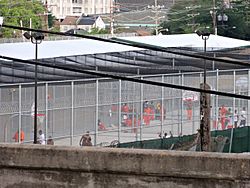Special Housing Units (SHU) syndrome
Some of the most extreme adverse effects suffered by prisoners appear to be caused by solitary confinement for long durations. When held in "Special Housing Units" (SHU), prisoners are subject to sensory deprivation and lack of social contact that can have a severe negative impact on their mental health.
A psychopathological condition identified as "SHU syndrome" has been observed among such prisoners. Symptoms are characterized as problems with concentration and memory, distortions of perception, and hallucinations. Most convicts suffering from SHU syndrome exhibit extreme generalized anxiety and panic disorder, with some suffering amnesia. [9]
The State-Trait Anxiety Inventory (STAI) was developed to understand the mechanisms behind anxiety. State anxiety describes anxiety that takes place in a stressful situation while trait anxiety is the tendency of feeling anxious in many situations because of a set of beliefs that an individual has that threatens their well-being. [10]
SHU syndrome is a term that was created by Psychiatrist Stuart Grassian to describe the six basic mechanisms that happen in a cognitive matter in prisoners that are in solitary confinements or supermax level cell prison. The six basic mechanisms that occur together are:
- Hyperresponsivity to External Stimuli
- Perceptual Distortions
- Illusions, and Hallucinations
- Panic Attacks
- Difficulties with Thinking
- Concentration and Memory
- Intrusive Obsessional Thoughts
- Overt Paranoia
Stuart Grassian proposed that the symptoms are unique and are not found in any other situation. [11]
Long durations may lead to depression and changes in brain physiology. In the absence of a social context that is needed to validate perceptions of their environment, prisoners become highly malleable, abnormally sensitive, and exhibit increased vulnerability to the influence of those controlling their environment. Social connection and the support provided by social interaction are prerequisites to long-term social adjustment as a prisoner.
Prisoners exhibit the paradoxical effect of social withdrawal after long periods of solitary confinement. A shift takes place from a craving for greater social contact to a fear of it. They may grow lethargic and apathetic, and no longer be able to control their own conduct when released from solitary confinement. They can come to depend upon the prison structure to control and limit their conduct.
Long-term stays in solitary confinement can cause prisoners to develop clinical depression, and long-term impulse control disorder. Those with pre-existing mental illnesses are at a higher risk for developing psychiatric symptoms. [12] Some common behaviours are self-mutilation, suicidal tendencies, and psychosis. [9]









